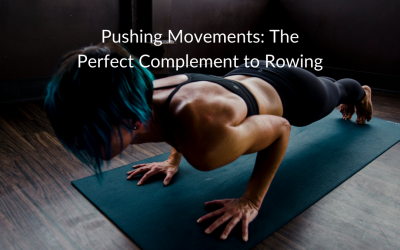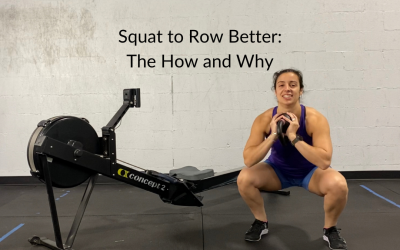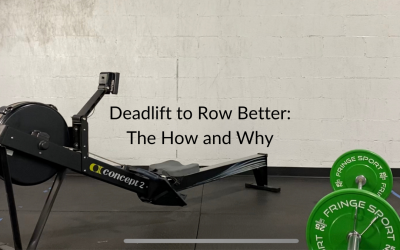How to Combine Strength Training and Indoor Rowing Workouts
If you want to up your rowing game with some strength training, then this is the post for you. After purchasing a strength program from a coach, these are some things you want to consider when you’re combining your strength and rowing workouts.
I’ll throw in this caveat too that if you have never made a program yourself, please make sure that you are purchasing a program from a coach who knows how to give you the right spread of strength movements and knows how to progress you safely. Please don’t build a strength program on your own if you don’t have the knowledge to be able to do it properly.
Maybe you have, or maybe you have never strength trained. That’s okay. You’ll still be able to understand these tips, even if you have or have not.
The 6 Movements
Strength training is made up of six general movements, and I’m going to briefly go over each one. The first one is the squat. These are things like front squats, back squats, goblet squats, any movement where our knees, ankles, and hips are bending and extending.
Next is a hinge. Hinge movements are Romanian deadlifts (RDLs), deadlifts, and single-leg RDLs. Hinge movements mean that we are hinging from our hips during the exercise.
The third is a lunge. Lunging gets us into using single leg exercises, using one leg at a time. This helps with balance and things like that. Any type of lunge, box step ups, things like that.
Next is going to be your pushing movements. Pushing movements are horizontal and vertical. Things like pushups are examples of horizontal pushes, and then things like overhead presses are examples of vertical pushes.
We also need the opposite of pushing, which brings us to pulling movements. These are exercises like bent over rows, which is a horizontal pulling movement. Vertical pulling movements are things like lat pull downs or pull ups/chin ups. Things of that nature.
The last movement is carry. Carry can also mean core work. And yes, a lot of these movements talked about previously do use your core. But as far as carry movements are concerned, it’s things like farmer carries, unilateral carries, overhead carries, anything where you are picking up a heavier weight than normal and walking it from one place to another.
Those are our six movement types. Squat, hinge, lunge, push, pull, and carry. Keep these in mind as we continue this conversation.
The Movements and Rowing
With the rowing stroke, rowing mimics three of these movements. That’s the squat, the hinge and the pull. At the start of the stroke, the ankles, knees, and hips are all bent. Then when we start the drive, everything’s extending. Our ankles, knees, and even our hips are extending. That’s the squat. Then when we open our body, that’s the hinge. Then when we pull into the finish, there is the pull.
Don’t Overtax
Why is that important when combining rowing and strength training? You don’t want to overtax yourself on the same movements, especially if you have a hard rowing workout to do.
If you have a very hard squat or deadlift day, or even a very hard pulling day, you could find that a rowing workout immediate after is a little bit harder that it normally is. This is because you’ve already taxed yourself so much in these movements that your body might not have as much to give on your rowing workouts.
That’s another point. Strength workouts before rowing workouts. Always do the strength first!
Do All 6 Movements
It’s important to do all six movement patterns when you’re strength training. Just because you want to get better at rowing, which is the squat hinge and pull, doesn’t mean that you should only squat, deadlift and bent over row. You should be doing ALL of the movement patterns because that way you are becoming more rounded, to help you build a healthier body overall. Don’t just squat hinge and pull to get better at rowing.
Do all of them! Pushing movements especially, because that’s the biggest muscle group you’re missing when you row.
Steady State after Strength
How do you apply what I’ve mentioned? When you have a heavy squat, deadlift, or pull day, try to have your rowing workout be a steady state workout. If you have to do a hard rowing workout after strength training, and it can’t be on a separate day, I recommend doing it on a push day. So, if you have pushups that day or some overhead presses, do those hard interval rowing workouts after that kind of a strength training focused day. That’s my biggest recommendation to combining strength and rowing.
Your Training Schedule
You don’t have to strength train and row on the same day. It’s entirely up to you and your schedule.
For example, if you know you want to strength train twice a week and row three times a week, there’s a couple of ways you can make that work.
You can do one on each day for five workouts on five days. So, you would row, strength train, row strength train, and row. Alternating the days would be the best way to do that, along with putting a rest day in the middle somewhere. That’s the first example.
Another way you can do it is to combine your strength training and rowing for two days and have a separate rowing day for the third workout. This gives you three days’ worth of workouts. You can do strength and steady state, strength and mid-distance, and then have the short, fast, hard interval workouts on a separate day. I recommend saving your hardest rowing workout for the day you don’t strength train. The training days would be a little bit longer because you would need to strength train and then row. You would need more time on those days if you chose to do it that way.
RowStrong!
If you’re looking to get into strength training more, I have a program coming out soon called RowStrong that’s a strength program for rowers.
Currently there’s a waitlist to hear about when it comes out. If you’re interested in hearing more, click here to go get on the waitlist.
It’s a combo of both strength training and rowing. Two days of strength training with three rowing workouts. One of the rowing workouts is more of a high intensity circuit with on and off machine movements.
Thank you for getting all the way through this post, where we talked about combining strength training and rowing. Whether that’s a program that you got from a rowing instructor, or whether it’s a separate strength training and rowing program that you’re trying to combine in the best possible way.
Pushing Movements: The Perfect Complement to Indoor Rowing
With all of that pulling you’re doing while rowing, there’s one motion your body isn’t getting stronger at. That’s pushing! Since rowing uses 85% of your muscles, it’s easy to think that’s all you need to do. However, there are other movements your body is missing out...
Squat to Row Better – The Why and How
How in the world can you get better split times on the rowing machine? Maybe you’ve been working on your technique day in and day out, and you’ve reached a point where you’re not seeing progress anymore. Once your technique is mostly dialed in, the next best way to...
Deadlift to Row Better: The Why and How
How in the world can you get better split times on the rowing machine? Maybe you’ve been working on your technique day in and day out, and you’ve reached a point where you’re not seeing progress anymore. Once technique is mostly dialed in, the next biggest way to...



